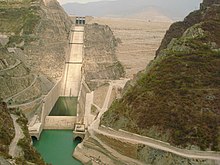Tehri Dam
The Tehri Dam is a multi-purpose rock and earth-fill embankment dam on the Bhagirathi River near Tehri in Uttarakhand, India. It is the primary dam of the Tehri Hydro Development Corporation Ltd. and the Tehri hydroelectric complex. Phase 1 was completed in 2006, the Tehri Dam withholds a reservoir for irrigation, municipal water supply and the generation of 1,000 MW of hydroelectricity. Two more phases with an additional 400 MW and 1,000 MW pumped storage hydroelectricity are under construction.[1]
History

A preliminary investigation for the Tehri Dam Project was completed in 1961 and its design was completed in 1972 with a 600 MW capacity power plant based off the study. Construction began in 1978 after feasibility studies but was delayed due to financial, environmental and social impacts. In 1986, technical and financial assistance was provided by the USSR but this was interrupted years later with political instability. India was forced to take control of the project and at first it was placed under the direction of the Irrigation Department of Uttar Pradesh. However, in 1988 the Tehri Hydro Development Corporation was formed to manage the dam and 75% of the funding would be provide by the federal government, 25% by the state. Uttar Pradesh would finance the entire irrigation portion of the project. In 1990, the project was reconsidered and the design changed to its current multi-purpose. Construction on the Tehri Dam was complete in 2006 while the second part of the project, the Koteshwar Dam, remains ongoing.[1]
Technical description
The dam is a 260 metres (850 ft) high rock and earth-fill embankment dam. Its length is 575 metres (1,886 ft), crest width 20 metres (66 ft), and base width 1,128 metres (3,701 ft). The dam creates a reservoir of 2.6 cubic kilometres (2,100,000 acre⋅ft) with a surface area of 52 square kilometres (20 sq mi). The installed hydrocapacity is 1,000 MW along with an additional 1,000 MW of pumped storage hydroelectricity.
The Tehri Dam and the Tehri Pumped Storage Hydroelectric Power Plant are part of the Tehri Hydropower Complex which also includes the 400 MW Koteshwar Dam downstream.[1] The complex will afford irrigation to an area of 270,000 hectares (670,000 acres), irrigation stabilization to an area of 600,000 hectares (1,500,000 acres), and a supply of 270 million imperial gallons (1.2×106 m3) of drinking water per day to the industrialized areas of Delhi, Uttar Pradesh and Uttarakhand.
Environmental issues

The Tehri Dam has been the object of protests by environmental organizations and local people of the region. In addition to the human rights concerns, the project has spurred concerns about the environmental consequences of locating a large dam in the fragile ecosystem of the Himalayan foothills. There are further concerns regarding the dam's geological stability. The Tehri dam is located in the Central Himalayan Seismic Gap, a major geologic fault zone. This region was the site of a 6.8 magnitude earthquake in October 1991, with an epicenter 500 kilometres (310 mi) from the location of the dam. Dam proponents claim that the complex is designed to withstand an earthquake of 8.4 magnitude, but some seismologists say that earthquakes with a magnitude of 8.5 or more could occur in this region [citation needed]. Were such a catastrophe to occur, the potentially resulting dam-break would submerge numerous towns downstream, whose populations total near half a million.

The relocation of more than 100,000 people from the area has led to protracted legal battles over resettlement rights, and ultimately resulted in the project's delayed completion.
Since 2005, filling of the reservoir has led to a reduced flow of Bhagirathi water from the normal 1,000 cubic feet per second (28 m3/s) to a mere 200 cubic feet per second (5.7 m3/s). This reduction has been central to local protest against the dam, since the Bhagirathi is considered part of the sacred Ganges whose waters are crucial to Hindu mythology. At some points during the year, the tampering with Bhagirathi waters means this tributary stops flowing. This has created resentment among many Hindus, as the sanctity of the Ganges has been greatly compromised for the generation of electricity.Though the officials say that when the reservoir is filled to its maximum capacity the flow of the river will again become normal. In spite of concerns and protestation, operation of the Tehri Dam continues.
References
- Tehri dam, a factsheet published by International Rivers (October 2002)
- Official website of the Tehri Hydro Development Corporation Limited, the organization in charge of the dam's construction
- Tehri: The Sinking Town a traveller's account of Tehri dam.
- Gaur, Vinod K. and Valdiya, K. S. (1993) Earthquake Hazard and Large Dams in the Himalaya Indian National Trust for Art and Cultural Heritage, New Delhi, ISBN 81-900281-4-X
External links
![]() Media related to Tehri Dam at Wikimedia Commons
Media related to Tehri Dam at Wikimedia Commons
- Tehri Hydro Power Complex on the Bhagirathi River in India Journal Power Technology and Engineering (formerly Hydrotechnical Construction), Springer, New York ISSN 1570-145X (Print) 1570-1468 (Online) Vol. 34, No. 8-9 / Aug, 2000 DOI 10.1023/A:1004187208788, pp 479-484, November 02, 2004


